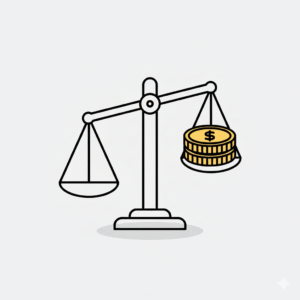Complete guide for investing in the stock market

The stock market. For many, the phrase conjures images of chaotic trading floors, complex charts, and a high-stakes game reserved for the financial elite. But that perception is a relic of the past. Today, investing in the stock market is more accessible than ever, and it stands as one of the most effective and proven methods for building long-term wealth.
Think of it this way: investing in the stock market is simply becoming a part-owner in the world’s most successful and innovative companies. It’s about putting your money to work, allowing it to grow and compound over time, and building a more secure financial future for yourself.
This is your complete, beginner-friendly guide to getting started. We will walk you through every essential step, from setting your first financial goals to making your first investment and beyond. We’ll demystify the jargon and provide a clear, actionable roadmap to help you invest with confidence.
Step 1: Laying the Foundation – Your Pre-Investment Checklist

Before you invest your first dollar, it’s crucial to build a solid financial foundation. Taking these preliminary steps will ensure you are investing responsibly and not putting your essential finances at risk.
Define Your “Why”: Setting Clear Financial Goals
Why do you want to invest? The answer to this question will shape your entire investment strategy. Your goals determine your time horizon—how long you have to invest—which is the single most important factor in deciding how much risk you can afford to take.
- Long-Term Goals (10+ years): This is the sweet spot for stock market investing. Goals like retirement, which may be decades away, allow you to ride out the market’s natural ups and downs.
- Medium-Term Goals (5-10 years): Goals like a down payment for a house fall into this category. You’ll want a balanced approach, as you have less time to recover from a major downturn.
- Short-Term Goals (Less than 5 years): This includes saving for a car, a vacation, or an emergency fund. Money for short-term goals should not be in the stock market. The risk of losing principal when you need the cash is too high. High-yield savings accounts or CDs are better suited for these goals.
Build Your Emergency Fund
An emergency fund is your financial safety net. It’s 3-6 months’ worth of essential living expenses kept in a separate, easily accessible savings account. This fund is non-negotiable. It ensures that if you face an unexpected job loss or a medical emergency, you won’t be forced to sell your investments at a loss to cover the costs.
Pay Down High-Interest Debt
It’s difficult to get ahead financially when you’re paying high interest rates on debt. Credit card debt, with interest rates often exceeding 20%, can cancel out even the best investment returns. Before making significant investments, it’s wise to have a plan to aggressively pay down any high-interest consumer debt.
Step 2: Opening the Gateway – Choosing Your Brokerage Account
To buy and sell stocks, you need a special account called a brokerage account. This is the platform that connects you to the stock market.
What is a Brokerage Account?
Think of a brokerage account as a bank account specifically for your investments. You deposit cash into it, and then you can use that cash to buy stocks, ETFs, mutual funds, and other securities. Opening one is a simple online process that usually takes less than 15 minutes.
Types of Brokerage Accounts
You’ll encounter a few different types of accounts, each with its own purpose and tax benefits.
- Standard Brokerage Account (Taxable Account): This is the most flexible type of account. You can deposit and withdraw money at any time. However, you will have to pay taxes on your investment gains (capital gains) and dividends in the year they are realized.
- Individual Retirement Account (IRA): These are tax-advantaged accounts designed specifically for retirement savings.
- Traditional IRA: Contributions may be tax-deductible, your investments grow tax-deferred, and you pay income tax on withdrawals in retirement.
- Roth IRA: You contribute with after-tax money (no upfront tax deduction), but your investments grow completely tax-free, and all qualified withdrawals in retirement are also tax-free. For many investors, the Roth IRA is an incredibly powerful wealth-building tool.
- 401(k) or 403(b): These are employer-sponsored retirement plans. If your employer offers one, especially with a matching contribution (free money!), it’s often the best place to start investing.
How to Choose a Broker
For most beginners, a reputable, low-cost online broker is the best choice. Here’s what to look for:
- Commissions and Fees: Look for brokers that offer $0 commission trades on stocks and ETFs.
- Account Minimums: Choose a broker with no minimum deposit requirement to get started.
- User-Friendly Platform: The website and mobile app should be intuitive and easy to navigate.
- Educational Resources: Good brokers offer a wealth of articles, videos, and tutorials for beginners.
Reputable options in the U.S. include Fidelity, Charles Schwab, and Vanguard.
Step 3: Your Investment Toolkit – Understanding What to Buy

With your account open and funded, it’s time to decide what to invest in. While you can buy individual company stocks, a much simpler and safer approach for beginners is to start with diversified, low-cost funds.
Individual Stocks
Buying a share of a company’s stock (e.g., Apple – AAPL) makes you a part-owner of that business. Its potential for high returns is significant, but so is its risk. Your success is tied to the fortune of that single company. Picking individual stocks requires significant research and can be a challenging endeavor for newcomers.
Exchange-Traded Funds (ETFs)
ETFs are a beginner’s best friend. An ETF is a single fund that holds a basket of hundreds or even thousands of different stocks, often designed to track a specific market index.
- Example: The S&P 500 ETF. An S&P 500 ETF (like VOO or IVV) holds shares of the 500 largest U.S. companies. By buying just one share of this ETF, you instantly achieve diversification across the broad U.S. market.
- Benefits: ETFs offer instant diversification, have very low management fees (expense ratios), and trade on the stock exchange throughout the day like a regular stock.
Mutual Funds
Mutual funds are similar to ETFs in that they pool money from many investors to buy a diversified portfolio of assets. Index mutual funds (like Vanguard’s VTSAX, which tracks the total U.S. stock market) are very similar to their ETF counterparts and are excellent choices for long-term investors. A key difference is that mutual funds are priced only once per day after the market closes.
For most beginners, starting with a broad-market index ETF or mutual fund is the most recommended strategy. It’s simple, effective, and provides the diversification needed to reduce risk.
Step 4: Making Your First Move – Placing an Order
You’ve chosen your first investment. Now it’s time to buy it through your broker’s “trade ticket” or order form. You’ll need to specify two key things:
Quantity: How Much to Buy
You can specify the number of shares you want to buy. Many brokers now also offer fractional shares, which allow you to invest by a dollar amount. For example, you can choose to buy “$100 worth of VOO,” even if a full share costs more than that. This is a fantastic feature for beginners investing with smaller amounts.
Order Type: How You Want to Buy It
- Market Order: This is the simplest option. It tells your broker to buy the investment immediately at the best available price. The trade will execute almost instantly.
- Limit Order: This gives you more price control. You set a specific price you’re willing to pay. The order will only execute if the investment’s price hits your target price or lower.
For long-term investors buying diversified ETFs, a market order is perfectly fine. Once you place the order, you’ll see a confirmation, and congratulations—you are officially an investor!
Step 5: The Long Game – Principles for Long-Term Success

Investing is not a get-rich-quick scheme. True wealth is built through discipline and patience over many years. Embracing the right mindset is just as important as choosing the right investments.
The Magic of Compounding
Compounding is the engine of wealth creation. It’s the process where your investment returns start generating their own returns. When your ETF pays a dividend, reinvesting that dividend buys you more shares, which in turn generate even more dividends. The longer you stay invested, the more powerful this snowball effect becomes.
Consistency is Key: Dollar-Cost Averaging
Don’t try to “time the market” by guessing when it’s low or high. A far more effective strategy is dollar-cost averaging. This simply means investing a fixed amount of money at regular intervals (e.g., $200 every month), regardless of what the market is doing.
This approach automates your investing and removes emotion. When the market is down, your fixed investment buys more shares. When the market is up, it buys fewer. Over time, this can lower your average cost per share and lead to better returns.
Manage Your Emotions: The Psychology of Investing
The stock market will have down years. It’s a normal and expected part of investing. The key to success is to not panic when it happens. Fear and greed are the investor’s worst enemies. Having a solid plan and sticking to it—continuing to invest consistently through both good times and bad—is what separates successful investors from the rest. Remember, you are investing for the long term. Short-term volatility is just noise.
Review and Rebalance Periodically
Once a year, it’s a good idea to review your portfolio. Over time, as some investments grow faster than others, your asset allocation can drift from its original target. For example, if your target was 80% stocks and 20% bonds, a strong stock market might cause your portfolio to become 90% stocks. Rebalancing involves selling some of the assets that have performed well and buying more of the underperforming ones to return to your target allocation. This enforces a “buy low, sell high” discipline and helps manage risk.
By following this guide, you have a complete framework for starting your investment journey. The path to financial independence is a marathon, not a sprint. Start with a solid foundation, choose a simple, diversified strategy, be consistent, and let the power of time and compounding work its magic.







